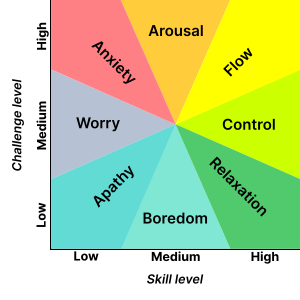Flow theory is a psychological concept that is gaining interest in e-learning. It is a concept that should be also considered in the fields of User Assistance and Technical Communication.
Flow is akin to sportsmen being “in the zone” – flow is the situation where people are happiest when they are completely engaged in a task.

Online Help has been traditionally interruptive – people have to subconsciously admit they have failed and need to seek assistance from a Help file, Web page or user guide. The adoption of the term “User Assistance”, instead on online Help, is part of movement towards new models for minimising the situations where users get stuck, helping them quickly should that happen.
The conditions necessary to achieve the flow state include:
- Having clear goals
- Direct and immediate feedback
- The right balance between the user’s ability level and the task
- An activity that is intrinsically rewarding.
Flow-based User Assistance complements concepts such as adaptive content, as it implies content should adapt dynamically to explain information in the most suitable way. It also complements ideas such as affective assistance, conversation and community based documentation, in that these may be a more suitable “tone of voice” in certain circumstances.
In practice, this means that User Assistance is likely to be embedded into the User Interface – for example, helping explain what certain concepts mean, and what makes a good choice.
It is a very good approach to take if you are developing apps for mobile phones or tablets. This is, in part, because the iOS operating system has limited multitasking capabilities – you have to interrupt one activity in order to do another.

To adopt a flow-based approach, User Assistance must be planned and considered from the very start of any software project. As it is not a bolt-on to the application, it cannot be left to the end of the project. Guidance text becomes located in numerous different places.
The reward for taking this approach is that users get stuck less often, enjoy the application more and become more capable users, perhaps even at peak performance.

Thanks, Ellis, for the thoughtful post which actually sent me back to Cszikszentmihalyi’s original Flow book to mull things over for a bit. I agree that conventional documentation is (post-)disruptive in the sense that you’ve already fallen out of Flow when you start to look for the right topic to get you back into it.
The more flow-supporting alternative you suggest sounds like it can benefit from the concept of “Progressive Disclosure” as Andrea Ames presented it at #STC12 in Chicago, see http://ffeathers.wordpress.com/2012/05/23/stc-summit-day-2-progressive-disclosure/ and http://idratherbewriting.com/2012/08/09/applying-progressive-information-disclosure-to-online-help-navigation/
For a similar approach to usability (and, indirectly, documentation), see Kathy Sierra’s classic “Kick Ass Curve” at http://headrush.typepad.com/creating_passionate_users/2005/10/getting_users_p.html
So I think flow-based user assistance would actually get us tech comm’ers out of literal technical writing, and into user experience design. In the meantime, I’d point out that while using documentation hardly ever is flow-based, writing it can very well be, given good tools and useful processes… 🙂